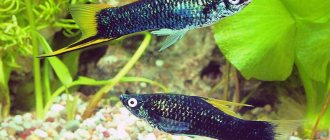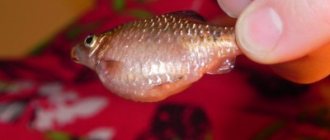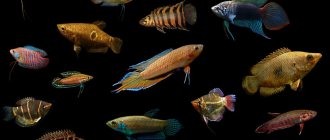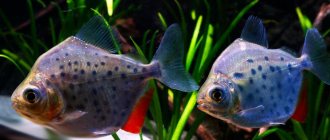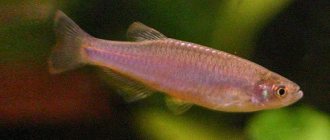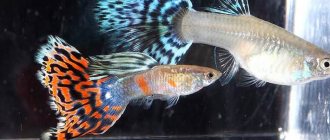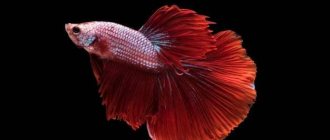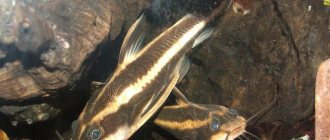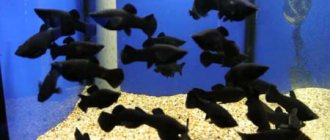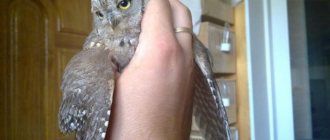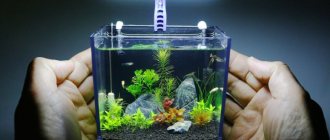Description and distinctive features
Clowns are small fish and in captivity do not exceed 7-11 cm in size. They have a torpedo-shaped body with a characteristic bulge on the forehead. The eyes are black with a bright orange iris. “Clownfish” refers to an orange amphiprion, but in a number of descriptions this name unites the entire genus.
The clown fish is called so because its appearance is similar to the attire of a circus performer. Mother Nature painted it too brightly.
At any age, the fish are colored the same: juicy stripes of orange, black and white alternate on the body.
There are varieties of amphiprions with a dominant dark blue color, as well as yellow and red individuals.
The dorsal fin of the clown fish has a notch and seems to be divided into two parts, the pectoral fins are hard and have spines, and the caudal fin is soft. All fins have a black contrasting edge.
An interesting feature of the amphiprion is its talkativeness. This aquarium fish makes clicking, grumbling and many other sounds. Which makes the clownfish an even more interesting and attractive pet.
Homeland of the orange amphiprion
The homeland of amphiprions is the Pacific Ocean, or more precisely, the reefs of the Pacific Ocean. They later appeared in the Indian Ocean and are now found throughout the waters from East Africa to French Polynesia and from Japan to Eastern Australia. They choose areas densely overgrown with reefs and inhabited by sea animones. Thanks to the knowledge of modern specialists, the habitat of these fish has expanded to incredible proportions. Now clowns can live comfortably in any city in any country in the aquarium of any interested person.
Clown in its natural environment.
The mystery of the name "clown"
Why are they called that? This question, of course, sounded from your lips when you first heard the name of this fish. It's time to figure it out. In fact, the secret is quite simple: appearance. The orange amphiprion has a flat body of a bright shade, decorated with white stripes. When moving, the fish makes swaying, twitching movements, as if it is nervous. In the eyes of the observer it looks funny, hence the name - cheerful and playful.
Symbiosis with sea anemones
The clownfish chooses as a home one or more sea anemones, coral polyps known for their deadly tentacles located around the mouth disc. They are penetrated by a network of stinging threads (nematocysts), which secrete a toxic substance that can paralyze small fish or crustaceans.
Surprisingly, sea anemone does not harm the clown fish. At the first meeting, the poison gets on the skin of the amphiprion and its mucus. The fish’s body immediately reacts to the irritant and develops immunity to it. In a similar way, the sea anemone itself protects itself from its stinging tentacles. After just a few minutes, the sea anemone no longer perceives the clown as a food object. The mixture of mucus with a toxic substance is a kind of camouflage that allows the sea anemone to mistake the clown fish for “one of its own.” The composition of the poison is unique for each polyp, so clownfish try not to swim far from their familiar predatory coelenterate friend.
Symbiosis of amphiprion and sea anemone.
Sea anemone and clown fish are a typical example of a relationship called commensalism . This is the initial stage of symbiosis, in which there is mutual benefit, but there is no strong dependence on each other. Anemones hide clowns from danger among their many tentacles, amphiprions drive away small predators, such as butterfly fish, from the polyp.
In captivity, clownfish are “friends” even with the green carpet anemone, the deadliest among aquarium species.
Sea creatures: fish from the cartoon “Finding Nemo”
Finding Nemo is a full-length computer-animated film released in 2003. Winner of the Oscar for best film of this genre, it is the fifth full-length animated film from Pixar. The film's box office exceeded all expectations: until the release of Shrek 2 in 2003, Finding Nemo was the highest-grossing animated film in history and was among the top ten highest-grossing films of all time. In the USA and Russia alone, more than 28 million DVD copies of the cartoon were sold, which was a record result in history. The film received favorable reviews from critics and audiences, with an approval rating on Rotten Tomatoes ranging from 98 to 100% (one of the best results in the history of the resource).
Maintenance and care
The minimum dimensions of an aquarium for keeping a pair of clown fish must be at least 80 * 45 * 35 cm, volume - from 80 liters.
Keeping a piece of the sea at home is a difficult and expensive task, but it’s so beautiful...
Shelters in the form of corals and grottoes will not be amiss; ideally, you can plant live sea anemones (Heteractis magnifica and Stichodactyla gigantea). Coral sand 3-5 mm in diameter is suitable as a soil.
Water parameters must adhere to the following indicators:
- acidity – 8.1 – 8.4 pH;
- water density – 1.021-1.023;
- salt content – 34.5 g/l;
- temperature – 25-26°C.
Water changes should be done either weekly by 1/10 of the total volume, or once every 2 weeks by 1/5. Filtration, aeration and timely cleaning of the aquarium are fundamental factors in the proper care of the sea reef.
According to information from experienced aquarists, the smaller the size of the marine aquarium, the more difficult it is to maintain biobalance in it. That is why species reef aquariums for the most part have impressive dimensions. This gives the fish more space and makes it easier for the owner.
Clouded leopard
Clouded leopards are excellent tree climbers. (Image credit: Arun Roysri/Getty Images)
According to the Smithsonian National Zoological Park, clouded leopards (Neofelis nebulosa) are not leopards (Panthera pardus), as their common name suggests, but a separate species of cat. They are smaller than leopards and other big cats. According to the San Diego Zoo, clouded leopards can grow up to 1 meter in length and weigh up to 25 kg. (, )
The clouded leopard population ranges from Nepal through Southeast Asia to China. However, according to the International Union for Conservation of Nature (IUCN), their population is fragmented and declining due to human activities such as deforestation and illegal hunting. They eat a variety of prey, including slow lorises (a type of small primate) and small deer. ()
Nutrition
In nature, the clown fish often feeds on the remains of fish that were not eaten by its friend the sea anemone. In an aquarium, amphiprions are absolutely not picky about food. They happily eat specialized dry food for reef fish; they will not refuse brine shrimp, shellfish, finely chopped shrimp, squid, or a mixture of fish meat and algae.
Video: feeding amphiprions
Feeding should be done several times a day, in small portions that the fish can swallow in a few minutes.
Puma
Puma has many names. (Image credit: JT Chapman / Shutterstock.com)
The puma (Puma concolor) is the most common large cat in the Americas and is known by many other names, including mountain lion and cougar. They can be found from southern Alaska and Canada in the western half of North America to southern Chile in lower South America, according to Panthera, a cat conservation organization. Their range used to be much larger, but they were driven out of eastern North America by humans, with the exception of a small population that still lives in Florida, USA. Many puma populations are believed to be declining in Central and South America due to threats such as habitat loss and illegal poaching, although their status in these regions is largely unknown. ()
The U.S. Forest Service says cougars can be more than 2.4 meters in length, including their tails, and weigh between 59 and 68 kilograms. However, according to the National Wildlife Federation, an American non-profit conservation organization, some cougars can grow even larger, weighing up to 100 kg. Cougars hunt small, medium and large prey throughout their range. In North America, pumas primarily eat deer, according to the IUCN. (, , )
Reproduction and lifespan
In the ocean, in its native element, a clown fish lives for about 10 years, but in an aquarium its life expectancy doubles.
An interesting fact is that all hatched Amphiprion fry are initially males. They have both male and female reproductive organs, but the former are well developed, the latter are in their infancy.
As they grow, the largest individuals transform into females. If one of them dies, the dominant male changes sex and takes the vacant place. He then chooses a sexual partner from the remaining males.
For spawning, clowns can also use a regular ceramic pot.
Clown fish are distinguished by monogamy; in nature, the stimulus for the beginning of reproduction is moonlight, in which male clown fish become more active. In captivity, this factor is not particularly important.
The female lays eggs next to the sea anemone, and in its absence, near corals or grottoes. The process takes about 2 hours and occurs mainly in the evening. Experienced breeders recommend turning off the lights in the aquarium between 10 pm and 11 pm and maintaining the water temperature at 26°C.
The new dad protects the clutch, removes unfertilized eggs from it, and ventilates it. Depending on the age and size of the female, during one spawning she can bring from 400 to 1500 eggs. The incubation period lasts from 7 to 10 days, after which the fry hatch. Their starting food is plankton.
The father will guard them until adulthood, but in practice the young are usually placed in a separate container. This does not affect their development and growth dynamics.
Video: breeding of sea clowns
How long do clowns live in an aquarium?
The lifespan of clowns in an aquarium is longer than in the depths of the sea. This is explained by the absence of danger in the form of predatory fish.
Clown in the sea
Life expectancy indicators range from 1 to 20 years. At home, with proper care, a fish lives, on average, from 10 years, but if the aquarist carefully and responsibly cares for the pet, it can delight you for two whole decades, or even more.
How long clowns live in an aquarium also depends on where the fish was purchased. Doubtful sellers sometimes like to make money on specimens caught at sea. Such clowns may be old or sick, and in general they are unsuitable for life in captivity. Therefore, when purchasing, it is very important to make sure that the fish is healthy and bred specifically for life in the aquarium. To do this, you should pay attention to the integrity of the coat and fins, bright and rich color, shiny and healthy eyes, and the absence of strange spots and swellings.
Also, the lifespan of a fish depends on its size: small clowns live less.
Careful monitoring of water parameters will protect the fish from diseases, and thereby you can increase the life expectancy of aquarium inhabitants.
Clown fish cost and selection criteria
When choosing fish for your reef aquarium, you should give preference to specimens born in captivity. They are more adapted to aquarium life and can more easily tolerate stress from changing surroundings.
Wild amphiprions can be infected with oodiniosis, cryptokaryosis and brooklynellosis; they very painfully experience relocation into a limited area and often die from this.
Before purchasing, you need to carefully examine your future pet. The fish should have a rich color, smooth scales, and clean, unclouded eyes. A clown must be a clown: lively, cheerful, active.
It is better to purchase fish from trusted breeders who have all the necessary certificates. The cost of the most common type (Amphiprion ocellaris) is about 1000 rubles, other types, depending on age and size, are estimated at 2000-4000 rubles.
The aquarium clown fish is considered the most unpretentious of all coral fish. It is suitable for both large species marine aquariums in an office or restaurant, and for home maintenance. A coral reef with anemones and amphiprions always looks spectacular, and watching a school of bright and cheerful clown fish will bring a lot of joy to their owner.
Lynx
The common lynx is the largest species of lynx. (Image credit: Javier Fernandez Sanchez/Getty Images)
Lynxes are wild cats with black tufts of fur on their ears and short tails. Found in North America, Europe and Asia. The bobcat (Lynx rufus) is the smallest of the four lynx species—only twice the size of a domestic cat—but other lynx can be much larger. The common lynx (Lynx lynx) is the largest species of lynx and can reach 1.3 meters in length and weigh up to 36 kg. Lynxes eat a variety of prey, including rodents, birds and deer. ()
Lyretail grouper or rainbow variola
0
Another deep-sea ocean resident that all divers really want to see and get. Meanwhile, the payback for catching this beautiful species of rock perch is sad - the meat and entrails of the lyretail grouper contain poison. If you eat it, there may not be a fatal outcome, but joint pain and dizziness will bother you for several more years!
Other
Video games
- Finding Nemo (2003) - based on the cartoon “Finding Nemo”
- Disney Friends (2007) - based on the cartoon "Finding Nemo"
- Kinect: Disneyland Adventures (2007) - based on the cartoon "Finding Nemo"
- Nemo's Reef (2012) - based on the cartoon "Finding Nemo"
- Disney Infinity (series) and Disney Infinity 3.0 (2013-2016) - based on the cartoon “Finding Dory”
- Rush: A Disney-Pixar Adventure - based on the animated film "Finding Dory"
Soundtracks
- Finding Nemo (soundtrack) (2003) - based on the cartoon "Finding Nemo"
- Finding Dory (soundtrack) (2016) - based on the animated film "Finding Dory"
Compatibility
Hepatus compare favorably with most of their relatives in their friendly disposition and somewhat timid character - at the slightest danger, the fish strives to hide in the stones.
Familiarize yourself with the features of keeping betta fish, mollies, swordtails, gourami, parrot fish, guppies, lalius, clown fish, barbs, astronotus, minors, zebrafish, goldfish, and aquarium catfish.
In large aquariums it gets along well with representatives of other species of equal size. Relations with smaller individuals are not so rosy: sometimes surgeons simply drive smaller neighbors into the corners.
The fry get along well together, huddling together in a small group. When they grow up, leave one, maximum two fish (and only if the size of the container allows). A more massive accumulation of adult hepatus can end in disaster - without sharing the space and favorite pebbles, they can fight, using their spines.
Blue-headed angel
0
Another scaly beauty made the right choice with its choice of habitat – it likes the coral reefs of the Maldives, Taiwan and Indonesia. An interesting fact is that the blue-headed angel is very shy and leads a solitary lifestyle. When frightened, it will make such a loud sound that it will frighten you too. But if you want to bring this bright decoration home from the ocean depths, then for the sake of one individual you will have to prepare an aquarium for as much as 900 liters!
×
Film series
Finding Nemo (2003)
Main article: Finding Nemo
Among the beautiful tropical sea elements, in the Great Barrier Reef, a clown fish named Marlin lives in solitude. He is raising his only son, Nemo. The ocean and the dangers that exist in it are very frightening to Marlin, and he protects his son from them as best he can, but young Nemo, suffering from excessive curiosity, really wants to find out more about the mysterious reef next to which they live.
When Nemo, ironically, finds himself far from home, and also faces the threat of becoming a tank fish's dinner, Marlin goes in search of his son. But Marlin, of course, understands that he won’t turn out to be a heroic rescuer and asks for help in searching for Dory, a royal blue fish who, although she suffers from the fact that she remembers almost nothing, can’t be found kinder in the entire vast ocean !
Finding Dory (2016)
Main article: Finding Dory
Dory is a blue tang, a friendly blue fish who suffers from memory loss. Dory strives to get rid of her illness and find her family. The film takes place off the coast of California a year after the end of the events of the first cartoon.
Finding Marlin (Future Cartoons)
Director Andrew Stanton commented in June 2016 on the possibility of Finding Marlin
", the third animated film "
Finding Nemo
", stated:
| “I really feel like it was the missing piece, emotionally, for the first cartoon. Now I never stopped saying anything because many new characters appeared, and we expanded the universe for this cartoon. And again, I'm very used to seeing the world keep opening up from the Toy Story cartoons... so I've learned to just say, as far as I'm concerned, I think everything that comes out in the first cartoon is wrapped up. But we'll see. With any other sequels, we're committed to trying to make sure that it's inevitable that all of these extended stories and journeys with these characters were part of the entire canon. And it's very difficult, but for me it's so rewarding when I experience it, whether it's a great second season of a TV show or another book in the series. This is a small club when it was successful. as many people may voice things they don't like or wish there were no expansions, sometimes it's really nice to go back and spend more time with these characters if they develop, if they grow, if they expand. So, I'm very pleased. I feel like it was just as hard, if not harder, on Finding Dory to make it feel inevitable and predetermined, and that it was always the bigger one." |
